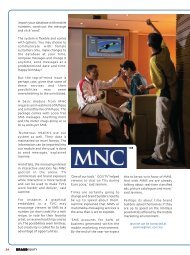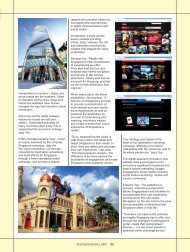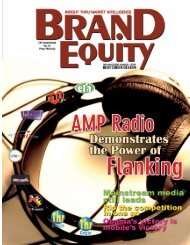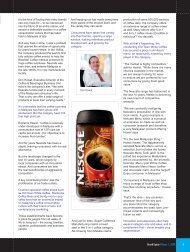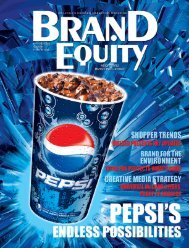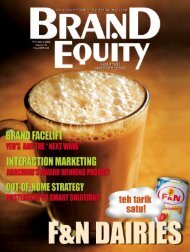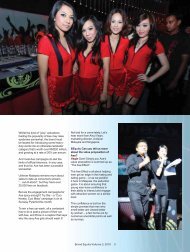SECOND BRAND STRATEGY - Brand Equity Magazine
SECOND BRAND STRATEGY - Brand Equity Magazine
SECOND BRAND STRATEGY - Brand Equity Magazine
You also want an ePaper? Increase the reach of your titles
YUMPU automatically turns print PDFs into web optimized ePapers that Google loves.
A second brand strategy is where a company with an<br />
existing brand (or brands) fi nds another segment of the<br />
market to address with a different brand<br />
proposition.<br />
<strong>BRAND</strong> <strong>STRATEGY</strong><br />
<strong>SECOND</strong> <strong>BRAND</strong> <strong>STRATEGY</strong><br />
At least, this should be what happens.<br />
In practice, it is often when an existing<br />
premium brand owner decides to<br />
discount its values into a second brand<br />
in order to penetrate a larger share of<br />
the market.<br />
However, the second brand need<br />
not be a discounted brand. Nestlé<br />
launched its Gold Blend brand at a<br />
premium to its Nescafé brand. Johnny<br />
Walker’s Black Label is at a premium<br />
to Red Label. Concorde was at a<br />
premium to British Airways.<br />
Key do’s<br />
1. Have a differentiated compelling<br />
brand proposition that you can<br />
uniquely deliver<br />
2. Address a market segment that is<br />
profi table<br />
3. Use a different sales and marketing<br />
team as a guardian for the different<br />
brand proposition<br />
4. If you are undercutting your existing<br />
premium brand(s), fi nd the magic<br />
operational formula that will deliver the<br />
brand proposition more cheaply<br />
Key don’ts<br />
1. Don’t simply discount your existing<br />
premium brand, as “premium brand,<br />
but cheaper”<br />
2. Don’t use the same sales and<br />
marketing team<br />
3. Don’t apply your existing overhead<br />
costs to the new brand.<br />
Multi-brand Strategies<br />
Many, if not most brand owners<br />
manage several brands in tandem.<br />
These can be:<br />
_Different brands into different product<br />
categories – e.g. chocolate bars<br />
and tooth paste<br />
_A carefully defi ned hierarchy of<br />
brands – for instance the hotel<br />
chains Six Continents and Accor. Car<br />
companies work the same way –<br />
BMW 3 vs. 5 vs. 7 series; VW vs.<br />
Skoda<br />
_A move upmarket – Gold Blend vs.<br />
Nescafé; Johnny Walker’s Black Label<br />
vs. Red Label<br />
_A move towards the mass market –<br />
Hilton International vs. Hilton<br />
National; Sony vs. Aiwa; BA vs. Go and<br />
KLM vs. Buzz (before they were<br />
both sold); Mercedes E vs. A class<br />
_A proliferation of brands – each time<br />
you develop a new product<br />
technology, you create a new brand<br />
name. This is less a brand strategy<br />
than a brand pile-up.<br />
Second <strong>Brand</strong> Strategies<br />
Offensive – by successfully launching<br />
new brands into the same market<br />
space, albeit targeted at different<br />
customer segments, you force your<br />
competitors out of the market. This is<br />
the opposite of the classic<br />
Japanese strategy of launching into a<br />
niche-of-a-niche and expanding<br />
out. Here you are expanding into the<br />
niches, and driving competitors out<br />
of the market.<br />
Defensive – when it became clear that<br />
the easyJet low cost strategy would<br />
work, other airlines had to respond.<br />
BA launched Go as a second brand in<br />
order to directly confront easyJet, but<br />
BA did not know how to run a cheap<br />
airline. KLM followed the same strategy<br />
with Buzz, to the same effect.<br />
Go now belongs to easyJet (and<br />
is fazing out the Go brand name),<br />
and Buzz has been acquired by<br />
Ryanair (who are killing the Buzz<br />
brand). British Midland took the whole<br />
company into the pricecompetitive<br />
section of the market, recognizing that<br />
there is no middle ground between<br />
the low cost airlines and the premium<br />
positioning.<br />
BA itself is offering competitively cheap<br />
fl ights, so long as they are booked<br />
suffi ciently in advance, under the BA<br />
brand. The lesson appears to be<br />
that defensive second branding does<br />
not work; there has to be a clearly<br />
thought out strategy, as with Levis and<br />
Dockers<br />
Opportunity-led – this is the strategy<br />
whereby second brands are launched<br />
or acquired because there is a realistic<br />
opportunity for them in the market<br />
place. IKEA can co-exist with Habitat.<br />
Hotel chains work well in brand<br />
hierarchies. Fanta would not benefi t<br />
from being called Coke<br />
How to Set-Up a<br />
Second <strong>Brand</strong><br />
Done correctly, setting up a second<br />
brand should be identical to setting<br />
up a fi rst brand. There needs to be:<br />
1. A profi table business model (so that<br />
it does not matter which brand gets<br />
the business)<br />
2. A clearly differentiated and<br />
compelling brand proposition<br />
3. A precise target customer<br />
segmentation<br />
4. A determined delivery of the brand<br />
proposition in the market<br />
5. A strategy of brand protection and<br />
exploitation. BE<br />
Source: This article has been sourced<br />
with permission from Mud Valley’s e-book<br />
‘Marketers from Space’ book; a compilation<br />
of all Mud Valley’s on-going brand<br />
marketing strategy articles. To purchase<br />
the e-book log on to http://www.mudvalley.<br />
co.uk/asp/shop.asp. This e-book contains<br />
the revolutionary new auto-refi ll feature.<br />
When you buy this e-book, you also buy<br />
the right to regular updates for at least two<br />
years, whereby you will receive new editions<br />
of the book with additions and amendments<br />
included.<br />
<strong>Brand</strong> <strong>Equity</strong> Volume 1, 2010 33
CO-CREATION TO THE FORE<br />
The situation is yet to normalize in<br />
the context of consumer confi dence<br />
and spending. So what options are<br />
open for brands in the space of<br />
brand communications? Are there<br />
more effective ways for engaging<br />
consumers? Should brand builders<br />
change the drumbeat, or the drum<br />
itself? Here are the considered<br />
viewpoints that emerged from the<br />
offi ce of the Chief Executive Offi cer<br />
of Publicis Malaysia, a brand<br />
communications agency that crafts<br />
solutions for brands such as Citibank,<br />
Nestle, Garnier, HP, Sanofi , MSIG, Sime<br />
Darby etc.<br />
<strong>Brand</strong> <strong>Equity</strong>: In the context of<br />
communications, what strategies<br />
should brand builders consider and<br />
implement to better manage the<br />
concerns of consumers – here and<br />
now?<br />
Dean Bramham: Today, consumers<br />
trust intangible brands like Google or<br />
facebook more than the brick-n-mortar<br />
ones.<br />
It’s not just about the online-offl ine<br />
equation. It’s about control. For too long<br />
we have been dictating consumers on<br />
what to do. Now the tables have turned.<br />
Equipped with superior information at<br />
their fi nger tips and a plethora of choice,<br />
consumers are deciding on a lot of things<br />
that they previously had no control on.<br />
We call it Co-Creation.<br />
Co-creation is in and here to stay. It’s<br />
time we relinquish some control to<br />
consumers and involve them in the<br />
brand development process – from<br />
designs, prices, distribution choices to<br />
communication nuances.<br />
We need to make the whole<br />
communication process a two-way<br />
dialogue from just a manufacturer’s<br />
monologue, the way it was all these<br />
years. Some of the best communication<br />
stories come from the consumers. We<br />
call this tool “Story Storming” and use<br />
it to a great extent in our planning and<br />
creative process.<br />
34 <strong>Brand</strong> <strong>Equity</strong> Volume 1, 2010<br />
<strong>Brand</strong> <strong>Equity</strong>: Shifting gears, what<br />
is your take on the idea that brand<br />
builders are slow to migrate to the<br />
online space, and that caution seems<br />
to guide their behavior?<br />
Dean Bramham: I will be blatantly<br />
honest here. Though every prediction<br />
points toward online budgets<br />
superseding all other mediums and<br />
yes, it has superseded in the west, I<br />
will be a bit more careful. A few factors<br />
drive this element of caution for me.<br />
One, internet penetration. If you keep<br />
Japan and Korea aside, penetration<br />
fi gures for most other markets are<br />
not as high as the West. But if you<br />
are talking to say the youth, it is a<br />
hugely impactful vehicle, irrespective<br />
of whether they are surfi ng from their<br />
bedrooms or cafes or cybercafés.<br />
Two, the content. We still lack the<br />
critical mass of talent. The good people<br />
are very few and far in between and<br />
in most cases, in the name of online<br />
communication, what we do is the<br />
same old oft-repeated few things. We<br />
need to invest and groom our talent<br />
pool for our markets to come up with<br />
cutting edge online stories.<br />
<strong>Brand</strong> <strong>Equity</strong>: Surely, there must be<br />
some key trends that will infl uence<br />
the way brand builders of the future<br />
will engage consumers. What are<br />
they?<br />
Dean Bramham: I will not get into a<br />
laundry list of trend-spotting here…<br />
but we at Publicis believe that the most<br />
important challenge is to think how you<br />
can change the category conversation<br />
in your favour. Like I mentioned, the<br />
consumer conversation is what will be<br />
making or breaking brands.<br />
Now how you manage the conversation<br />
in your favour is the key to your<br />
communication success. And I don’t<br />
mean online or blogs. Your brand story<br />
must have two elements – it must be<br />
Contagious and it must have an element<br />
of Co-Creation. Why this model helps is<br />
that you get your consumer to become<br />
your most effective medium and pass on<br />
the story.<br />
C-LEVEL VIEWPOINT<br />
“We need to<br />
make the whole<br />
communication<br />
process a<br />
two-way<br />
dialogue...”<br />
Dean Bramham<br />
The eternal ‘word of mouth’ is just being<br />
replaced by the ‘word of mouse’ or word<br />
on any other screen.<br />
<strong>Brand</strong> <strong>Equity</strong>: And how do you<br />
expect co-creation to impact the way<br />
business is conducted at Publicis<br />
Malaysia, and elsewhere?<br />
Dean Bramham: Co-creation will impact<br />
the way we do business in a big way.<br />
Who knows, maybe we can get the best<br />
consumer stories from the consumers<br />
themselves.<br />
Think of this scenario. A 28 year old male<br />
copywriter trying to write a story about<br />
the breakfast habits of a 35 year old<br />
housewife. Sure, backed by research<br />
and planning. Now all the data and<br />
information still makes his writing ‘fi ction’.<br />
He is imagining a scenario that will<br />
engage his consumer.<br />
To reiterate, what we are doing is<br />
involving the consumer in the process.<br />
As I mentioned, we call it story-storming;<br />
it’s all fi rsthand stories and little room for<br />
fi ction. Now chances of that ringing true<br />
are way higher than anything else.<br />
<strong>Brand</strong> <strong>Equity</strong>: <strong>Brand</strong> builders do need<br />
some potent advice with regards<br />
to how they should view 2010 and<br />
beyond. What would you urge them to<br />
consider, and do?<br />
Dean Bramham: It’s like Darwin’s<br />
‘Survival of the Fittest’ concept where<br />
only those that can adapt to change will<br />
survive.<br />
I believe that what you need to make<br />
these adaptations even possible<br />
are specialist talent, listening skills,<br />
passionate talent, open mindedness,<br />
out of the box talent, innovation, luck, a<br />
bit more talent and a clear belief that ‘no<br />
one knows anything’. BE
36 <strong>Brand</strong> <strong>Equity</strong> Volume 1, 2010<br />
6<br />
36<br />
36<br />
36<br />
36<br />
36<br />
36<br />
36<br />
36<br />
36<br />
36<br />
36<br />
36<br />
36<br />
36<br />
36<br />
36<br />
36<br />
36<br />
36<br />
36<br />
36<br />
36<br />
36<br />
36<br />
36<br />
36<br />
36<br />
36<br />
36<br />
36<br />
36<br />
36<br />
36<br />
36<br />
36<br />
36<br />
36<br />
36<br />
36<br />
36<br />
36<br />
36<br />
36<br />
36<br />
36<br />
36<br />
36<br />
36<br />
36<br />
36<br />
36<br />
36<br />
36<br />
36<br />
36<br />
36<br />
36<br />
36<br />
36<br />
36<br />
36<br />
36<br />
36<br />
36<br />
36<br />
36<br />
36<br />
36<br />
36<br />
36<br />
36<br />
36<br />
36<br />
36<br />
36<br />
36<br />
36<br />
36<br />
36<br />
36<br />
36<br />
36<br />
36<br />
36<br />
36<br />
36<br />
36<br />
36<br />
36<br />
36<br />
36<br />
36<br />
36<br />
36<br />
36<br />
36<br />
36<br />
36<br />
36<br />
36<br />
Br<br />
Br<br />
Br<br />
Br<br />
Br<br />
Br<br />
Br<br />
Br<br />
Br<br />
Br<br />
Br<br />
Br<br />
Br<br />
Br<br />
Br<br />
Br<br />
Br<br />
Br<br />
Br<br />
Br<br />
Br<br />
Br<br />
Br<br />
Br<br />
Br<br />
Br<br />
Br<br />
Br<br />
Br<br />
Br<br />
Br<br />
Br<br />
Br<br />
Br<br />
Br<br />
Br<br />
Br<br />
Br<br />
Br<br />
Br<br />
Br<br />
Br<br />
Br<br />
Br<br />
Br<br />
Br<br />
Br<br />
Br<br />
Br<br />
Br<br />
Br<br />
Br<br />
Br<br />
Br<br />
Br<br />
Br<br />
Br<br />
Br<br />
Br<br />
Br<br />
Br<br />
Br<br />
Br<br />
Br<br />
Br<br />
Bran<br />
an<br />
an<br />
an<br />
an<br />
an<br />
an<br />
an<br />
an<br />
an<br />
an<br />
an<br />
an<br />
an<br />
an<br />
an<br />
an<br />
an<br />
an<br />
an<br />
an<br />
an<br />
an<br />
an<br />
an<br />
an<br />
an<br />
an<br />
an<br />
an<br />
an<br />
an<br />
an<br />
an<br />
an<br />
an<br />
an<br />
an<br />
an<br />
an<br />
an<br />
an<br />
an<br />
an<br />
an<br />
an<br />
an<br />
an<br />
an<br />
an<br />
an<br />
an<br />
an<br />
an<br />
an<br />
an<br />
an<br />
an<br />
an<br />
an<br />
an<br />
an<br />
an<br />
an<br />
an<br />
an<br />
an<br />
and<br />
d<br />
d<br />
d<br />
d Eq<br />
Eq<br />
Eq<br />
Eq<br />
Eq<br />
Eq<br />
Eq<br />
Eq<br />
Eq<br />
Eq<br />
Eq<br />
Eq<br />
Eq<br />
Eq<br />
Eq<br />
Eq<br />
Eq<br />
Eq<br />
Eq<br />
Eq<br />
Eq<br />
Eq<br />
Eq<br />
Eq<br />
Eq<br />
Eq<br />
Eq<br />
Eq<br />
Eq<br />
Eq<br />
Eq<br />
Eq<br />
Eq<br />
Eq<br />
Eq<br />
Eq<br />
Eq<br />
Eq<br />
Eq<br />
Eq<br />
Eq<br />
Eq<br />
Eq<br />
Eq<br />
Eq<br />
Eq<br />
Eq<br />
Eq<br />
Eq<br />
Eq i<br />
ui<br />
ui<br />
ui<br />
ui<br />
ui<br />
ui<br />
ui<br />
ui<br />
ui<br />
ui<br />
ui<br />
ui<br />
ui<br />
ui<br />
ui<br />
ui<br />
ui<br />
ui<br />
ui<br />
ui<br />
ui<br />
ui<br />
ui<br />
ui<br />
ui<br />
ui<br />
ui<br />
ui<br />
ui<br />
ui<br />
ui<br />
ui<br />
ui<br />
ui<br />
ui<br />
ui<br />
ui<br />
ui<br />
ui<br />
ui<br />
ui<br />
ui<br />
ui<br />
ui<br />
ui<br />
ui<br />
ui<br />
ui<br />
uity<br />
ty<br />
ty<br />
ty<br />
ty<br />
ty<br />
ty<br />
ty<br />
ty<br />
ty<br />
ty<br />
ty<br />
ty<br />
ty<br />
ty<br />
ty<br />
ty<br />
ty<br />
ty<br />
ty<br />
ty<br />
ty<br />
ty<br />
ty<br />
ty<br />
ty<br />
ty<br />
ty<br />
ty<br />
ty<br />
ty<br />
ty<br />
ty<br />
ty<br />
ty<br />
ty<br />
ty<br />
ty<br />
ty<br />
ty<br />
ty<br />
ty<br />
ty<br />
ty<br />
ty<br />
ty<br />
ty<br />
ty<br />
ty<br />
ty<br />
ty<br />
ty Vo<br />
Vo<br />
Vo<br />
Vo<br />
Vo<br />
Vo<br />
Vo<br />
Vo<br />
Vo<br />
Vo<br />
Vo<br />
Vo<br />
Vo<br />
Vo<br />
Vo<br />
Vo<br />
Vo<br />
Vo<br />
Vo<br />
Vo<br />
Vo<br />
Vo<br />
Vo<br />
Vo<br />
Vo<br />
Vo<br />
Vo<br />
Vo<br />
Vo<br />
Vo<br />
Vo<br />
Vo<br />
Vo<br />
Vo<br />
Vo<br />
Vo<br />
Vo<br />
Vo<br />
Vo<br />
Vo<br />
Vo<br />
Vo<br />
Vo<br />
Vo<br />
Vo<br />
Vo<br />
Vo<br />
Vo<br />
Vo<br />
Vo<br />
Vo<br />
Vo<br />
Vo<br />
Vo<br />
Vo<br />
Vo<br />
Vo<br />
Vo<br />
Vo<br />
Vo<br />
Vo<br />
Vo<br />
Vo<br />
Vo<br />
Vo<br />
Vo<br />
Vo<br />
Vo<br />
Vo<br />
Vo<br />
Vo<br />
Vo<br />
Vo<br />
Vo<br />
Vo<br />
Vo<br />
Vo<br />
Vo u<br />
lu<br />
lu<br />
lu<br />
lu<br />
lu<br />
lu<br />
lu<br />
lu<br />
lu<br />
lu<br />
lu<br />
lu<br />
lu<br />
lu<br />
lu<br />
lu<br />
lu<br />
lu<br />
lu<br />
lu<br />
lu<br />
lu<br />
lu<br />
lu<br />
lu<br />
lu<br />
lu<br />
lu<br />
lu<br />
lu<br />
lu<br />
lume<br />
me<br />
me<br />
me<br />
me<br />
me<br />
me<br />
me<br />
me<br />
me<br />
me<br />
me<br />
me<br />
me<br />
me<br />
me<br />
me<br />
me<br />
me<br />
me<br />
me<br />
me<br />
me<br />
me<br />
me<br />
me<br />
me<br />
me<br />
me<br />
me<br />
me<br />
me<br />
me<br />
me<br />
me<br />
m 1<br />
1<br />
1<br />
1<br />
1<br />
1<br />
1<br />
1<br />
1<br />
1<br />
1<br />
1,<br />
,<br />
,<br />
,<br />
,<br />
, 20<br />
20<br />
20<br />
20<br />
20<br />
20<br />
20<br />
20<br />
20<br />
20<br />
20<br />
20<br />
20<br />
20<br />
20<br />
20<br />
20<br />
20<br />
20<br />
20<br />
20<br />
20<br />
20<br />
20<br />
20<br />
20<br />
20<br />
20<br />
20<br />
20<br />
20<br />
20<br />
20<br />
20<br />
20<br />
20<br />
20<br />
20<br />
20<br />
20<br />
20<br />
20<br />
20<br />
20<br />
20<br />
20<br />
20<br />
20<br />
20<br />
20<br />
20<br />
20<br />
20<br />
20<br />
20<br />
20<br />
20<br />
20<br />
20<br />
20<br />
20<br />
20<br />
20<br />
20<br />
20<br />
20<br />
20<br />
20<br />
20<br />
20<br />
20<br />
20<br />
20<br />
20<br />
20<br />
20<br />
20<br />
20<br />
20<br />
20<br />
20<br />
20<br />
20<br />
20<br />
2010<br />
10<br />
10<br />
10<br />
10<br />
10<br />
10<br />
10<br />
10<br />
10<br />
10<br />
10<br />
10<br />
10<br />
10<br />
10<br />
10<br />
10<br />
10<br />
10<br />
10<br />
10<br />
10<br />
10<br />
10<br />
10<br />
10<br />
10<br />
10<br />
10<br />
10<br />
10<br />
10<br />
10<br />
10<br />
10<br />
10<br />
10<br />
10<br />
10<br />
10<br />
10<br />
10<br />
CRM & WEB 2.0<br />
By Rosie Hong<br />
36 <strong>Brand</strong> <strong>Equity</strong> Volume 1, 2010
<strong>Brand</strong> <strong>Equity</strong> Volume 1, 2010 37<br />
Br<br />
Br<br />
Br<br />
Br<br />
Br<br />
Br<br />
Br<br />
Br<br />
Br<br />
Br<br />
Br<br />
Br<br />
Br<br />
Br<br />
Br<br />
Br<br />
Br<br />
Br<br />
Br<br />
Br<br />
Br<br />
Br<br />
B an<br />
an<br />
an<br />
an<br />
an<br />
an<br />
an<br />
an<br />
an<br />
an<br />
an<br />
an<br />
an<br />
an<br />
an<br />
an<br />
an<br />
and<br />
d<br />
d Eq<br />
Eq<br />
Eq<br />
Eq<br />
Eq<br />
Eq<br />
Eq<br />
Eq<br />
Eq<br />
Eq<br />
Eq<br />
Eq<br />
Eq<br />
Eq<br />
Eq<br />
E ui<br />
ui<br />
ui<br />
ui<br />
ui<br />
ui<br />
ui<br />
ui<br />
ui<br />
ui<br />
ui<br />
ui<br />
ui<br />
ui<br />
ui<br />
ui<br />
ui<br />
ui<br />
ui<br />
ui<br />
ui<br />
ui<br />
uity<br />
ty<br />
ty<br />
ty<br />
ty<br />
ty<br />
ty<br />
ty<br />
ty<br />
ty<br />
ty<br />
ty<br />
ty<br />
ty<br />
ty<br />
ty<br />
ty<br />
ty<br />
ty<br />
ty<br />
ty<br />
ty<br />
ty<br />
ty<br />
ty<br />
ty<br />
ty o<br />
Vo<br />
Vo<br />
Vo<br />
Vo<br />
Vo<br />
Vo<br />
Vo<br />
Vo<br />
Vo<br />
Vo<br />
Vo<br />
Vo<br />
Vo<br />
Vo<br />
Vo<br />
Vo<br />
Vo<br />
Vo<br />
Vo<br />
Vo<br />
Vo<br />
Vo<br />
Vo<br />
Volu<br />
lu<br />
lu<br />
lu<br />
lu<br />
lu<br />
lu<br />
lu<br />
lu<br />
lu<br />
lu<br />
lu<br />
lu<br />
lu<br />
lume<br />
me<br />
me<br />
me<br />
me<br />
me<br />
me<br />
me<br />
me<br />
me<br />
me<br />
me<br />
me<br />
me<br />
me<br />
me<br />
me<br />
me<br />
me<br />
me<br />
me<br />
me<br />
me 1<br />
1<br />
1<br />
1<br />
1<br />
1<br />
,<br />
,<br />
,<br />
,<br />
, 20<br />
20<br />
20<br />
20<br />
20<br />
20<br />
20<br />
20<br />
20<br />
20<br />
20<br />
20<br />
20<br />
20<br />
20<br />
20<br />
20<br />
20<br />
20<br />
20<br />
20<br />
20<br />
20<br />
20<br />
20<br />
20<br />
20<br />
20<br />
20<br />
20<br />
20<br />
20<br />
20<br />
20<br />
20<br />
20<br />
20<br />
2010<br />
10<br />
10<br />
10<br />
10<br />
10<br />
10<br />
10<br />
10<br />
10<br />
10<br />
10<br />
10<br />
10<br />
10<br />
10<br />
10<br />
10<br />
10<br />
10<br />
1 37<br />
37<br />
37<br />
37<br />
37<br />
37<br />
37<br />
37<br />
37<br />
37<br />
37<br />
37<br />
37<br />
37<br />
37<br />
37<br />
37<br />
37<br />
37<br />
37<br />
37<br />
37<br />
37<br />
37<br />
37<br />
37<br />
37<br />
37<br />
37<br />
37<br />
37<br />
BE<br />
<strong>Brand</strong> <strong>Equity</strong> Volume 1, 2010 37
The company website<br />
has become a<br />
key component to<br />
every organization’s<br />
marketing<br />
infrastructure. It is often<br />
the fi rst face to your<br />
prospects and as such must constantly<br />
be improved upon, added to, and/or<br />
modifi ed. Because we frequently design<br />
and develop content for websites, we<br />
recently asked Abbo Peterson, owner<br />
of website evaluation service provider<br />
Vista Point Consulting, what three web<br />
design guidelines he often sees missed.<br />
While there are a variety of elements<br />
to a successful website, here are some<br />
simple guidelines every website should<br />
follow — YET MANY DON’T:<br />
1. Your home page contains a clear<br />
tag line or company description that<br />
summarizes the website or your<br />
organization’s purpose<br />
For websites, the initial look is critical.<br />
In these fi rst few moments, there are<br />
lots of questions. Did we fi nd the right<br />
place? Does it offer what we need?<br />
Does it meet our expectations? Do we<br />
want to stay longer?<br />
You can help your website visitors<br />
feel more comfortable in seconds by<br />
using a very short phrase that clearly<br />
summarizes the purpose of your<br />
website.<br />
Tips:<br />
_Be clear and factual—this is not<br />
the time to use abstract slogans (i.e.<br />
Your complete resource for off-road<br />
motorcycling in Washington state)<br />
_Focus on what you provide and what<br />
benefi t your customers will get with<br />
your product or service (i.e. Improving<br />
websites with a new point of view)<br />
38 <strong>Brand</strong> <strong>Equity</strong> Volume 1, 2010<br />
_Use a complete phrase or sentence,<br />
rather than a list of words<br />
_Give the statement a prominent place<br />
on your website<br />
2. Your website contains the<br />
information commonly expected for<br />
the type of site<br />
Are you effectively answering your<br />
website visitors’ questions? The more of<br />
their questions you answer, the better<br />
they’ll feel about your organization, and<br />
the more successful your website will<br />
ultimately be.<br />
Tips:<br />
_Expected information may<br />
include product descriptions and<br />
photographs, service descriptions,<br />
prices, benefi ts, samples of work,<br />
event calendar, customer support<br />
information, FAQs, organization<br />
information, store locations, phone<br />
numbers, etc.<br />
_Possible questions to get you<br />
started include: a) How much does it<br />
cost; b) Do they offer the product or<br />
service I’m looking for; c) What are<br />
their hours; d) How are they better<br />
than their competitors; e) How long<br />
will it take to get the product shipped<br />
to me; or f) What is their email<br />
address and phone number?<br />
3. The link names throughout your<br />
site are clear and descriptive<br />
In one sense, using a website is like a<br />
treasure hunt—you follow clues to reach<br />
your destination.<br />
On a website, those clues are link<br />
names. If they lead to a destination<br />
your website visitors expect, they’ll feel<br />
confi dent and comfortable. If not, they<br />
can feel bewildered, even frustrated.<br />
WEB MARKETING<br />
TOP THREE BASICS MANY<br />
WEBSITES MISS!<br />
Tips:<br />
_Use accurate, descriptive link<br />
names. They should describe the link<br />
destination well enough so there is no<br />
surprise when someone clicks the link<br />
and views the resulting page.<br />
_Avoid link names like “click here” or<br />
“here.”<br />
_Links aren’t required to be just one or<br />
two words. When appropriate, use a<br />
phrase, e.g., “How the process works,”<br />
or “What clients are saying.”<br />
_For links to fi les, rather than web<br />
pages, indicate what type of fi le in<br />
or near the link, e.g., “Annual Report<br />
(.pdf)”.<br />
_For email links, make the link text the<br />
actual email address. Avoid links named<br />
“contact us” that can surprise people<br />
by unexpectedly launching an email<br />
application.<br />
_Test your link names by asking, “Is the<br />
link destination about ?” (For example:<br />
Is the link destination about “available<br />
services”? or Is the link destination<br />
about “click here”?)<br />
Whether you are planning a new or<br />
redesigned site or simply want to<br />
learn some ways to improve what<br />
you currently have, be sure you have<br />
covered these top three basics! BE<br />
This article is brought to you by Go-To-<br />
Market Strategies, a resource center for<br />
sales and marketing professionals and<br />
business leaders. We help companies<br />
practically integrate the magic of marketing<br />
with the science of sales through Sales<br />
& Marketing articles, tips, templates,<br />
toolkits and more. For details log on to<br />
www.gtms-inc.com.
By Russell Volckmann<br />
1. Marketing metrics will fl ourish in<br />
2010. In 2011, marketers will begin<br />
to realize that the metrics alone<br />
will not salvage their failing brands.<br />
As quarterly upticks on marketing<br />
dashboards become real time,<br />
marketing damage control teams<br />
will trip over themselves scrambling<br />
to be accountable for sales by the<br />
millisecond. <strong>Brand</strong>s that survive the<br />
melee will have learned to lead by<br />
example and purpose rather than just<br />
cater to analytic trends of the moment...<br />
And/or a deeper understanding of what<br />
those numbers imply. Not just living in<br />
the moment, but brands’ future reasons<br />
for being. Nearly every demographic<br />
today is more concerned with their<br />
future than ever before in modern<br />
history.<br />
2. More fi nancial & banking<br />
institutions, large & small, will fail—<br />
driven by (a) a consumer backlash<br />
against higher credit card interest rates<br />
and other forms of legalized usury; (b)<br />
general job losses that force a new<br />
wave of foreclosures on traditionally<br />
secure demographics. Newer, more<br />
relevant bank brands emerge.<br />
3. Credit Cards as we know them<br />
will begin to disappear, replaced<br />
increasingly by prepaid debit cards.<br />
We’ll get new names and brands for<br />
these.<br />
4. Accountability will kill many<br />
well-known and major brands—from<br />
automobiles to kids’ toys. These brands<br />
40 <strong>Brand</strong> <strong>Equity</strong> Volume 1, 2010<br />
<strong>BRAND</strong>S 2010<br />
TEN 2010 PREDICTIONS<br />
FOR <strong>BRAND</strong>S<br />
founder of VÖLCKMANN (& friends), a marketing, branding & identity<br />
boutique agency in San Francisco, Montreal, and New York.<br />
Recently, someone asked me to step up to the plate<br />
and predict 2010 brand trends. Well, here are 10<br />
stunningly accurate 2010 predictions from the<br />
branding crystal ball... enjoy!<br />
must deliver on promise or become<br />
irrelevant, dying the slow death of<br />
commodity brands. Or the quick death<br />
of brands that misrepresent who they<br />
are. The divide between relevant<br />
brands and irrelevant brands will come<br />
to an apex in 2010. New players in<br />
a given brand space will be more<br />
authentic, more relevant, deliver in<br />
practice on all touchpoints, and gain<br />
market share—overwhelming the<br />
status quo brands, or absorbed by<br />
status quo brands trying to salvage<br />
themselves.<br />
5. Major US automobile companies<br />
will fail in the absence of further<br />
government bailouts. Governments<br />
will begin to examine buying back<br />
rights of way for trains and other<br />
alternative transportation modes. More<br />
relevant upstart auto/transportation<br />
brands will get the attention they<br />
deserve.<br />
6. Death of the barking 30-second<br />
commercial. Rise in brand advertising.<br />
Any medium. As audiences reach the<br />
boiling point in an over-saturated world<br />
of media, and the fact that only 6% of<br />
audiences believe an ad is telling the<br />
truth anyway—ad dollars will be pulled<br />
out of trad 30-second TV spots (or the<br />
ones reformatted for online) faster than<br />
you can say “buy it now”. Experiential<br />
branding—virtual and real—will fi ll the<br />
void, along with branded efforts that<br />
offer real value (on physical, intangible,<br />
or emotional levels) in product,<br />
message, and experience.<br />
7. Facebook fi nally gets smarter<br />
about digital music/video distribution,<br />
aggregation, and streaming—doing a<br />
better job integrating artists, publishers,<br />
and fans. MySpace will never get this<br />
fast enough, despite building a brand<br />
around the music scene. MySpace<br />
continues to lose market share to<br />
Facebook. Once Facebook gets<br />
onboard with serious music & video<br />
integration, MySpace is left in the dust.<br />
8. Internet Video/Broadcast makes<br />
Broadcast Television a novelty... in<br />
the same way that newspapers and<br />
magazines are folding due to content<br />
explosion on the Internet, so will the TV<br />
as we know it. See #6 above as one of<br />
several smoking guns.<br />
9. Store brands (house brands), like<br />
Trader Joe’s (although not necessarily<br />
Trader Joe’s store brands), sales will<br />
soar in 2010 throughout traditional<br />
commodities like food, energy, and other<br />
lower tier priced supplies. Manufacturer<br />
brands in these categories will need to<br />
offer a more than just a cute jingle to<br />
justify their existence in today’s market.<br />
10. <strong>Brand</strong>ing will become<br />
increasingly important in 2010 from<br />
positioning, building, and management<br />
standpoints, as companies begin to<br />
realize the only way to sustainability<br />
is through holistic and kinetic brand<br />
integration. <strong>Brand</strong>s will be in motion<br />
more, but increasingly so in order to<br />
stay true to their brands and relevant to<br />
audiences. BE




